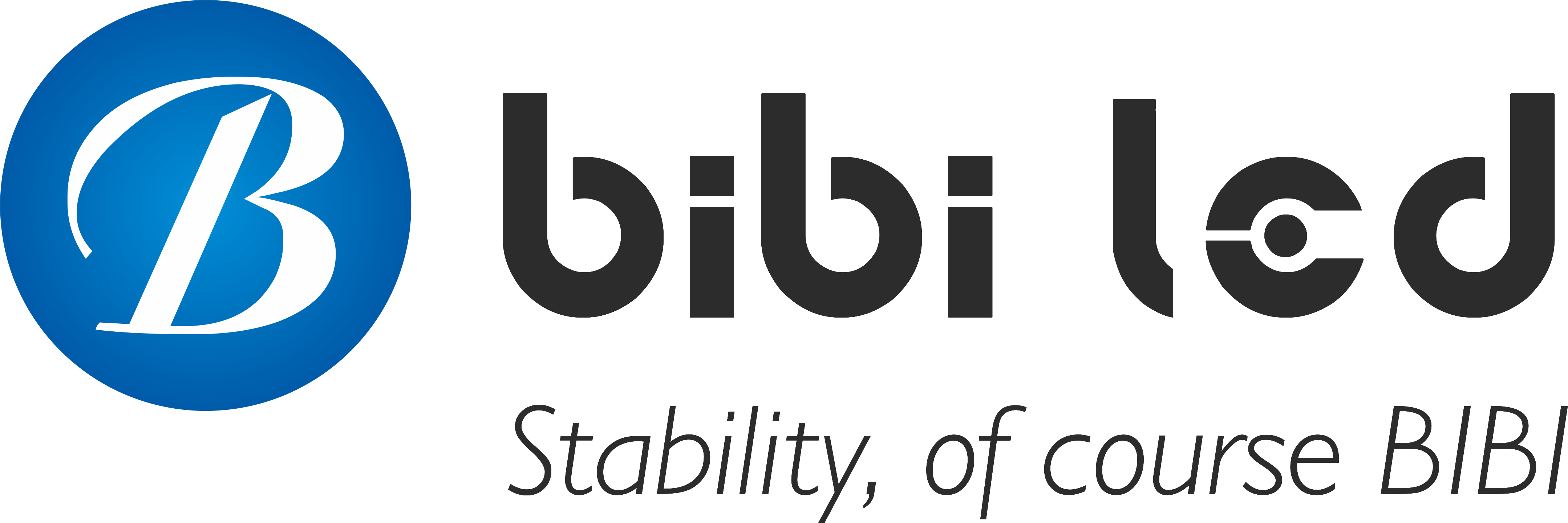소개
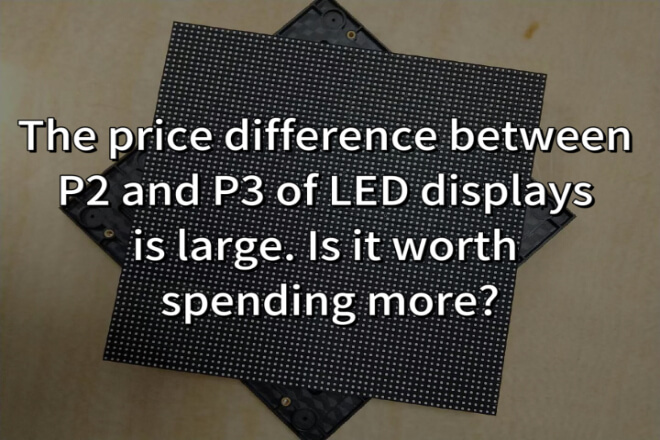
선택할 때 발광 다이오드 표시 스크린P2와 P3의 가격 차이에 얽매인 적이 있으신가요?
추가 비용을 지불할 가치가 정말 있을까요? 디스플레이 효과와 적용 가능한 시나리오의 차이점은 무엇인가요?
이 글은 여러분의 이런 질문에 대한 답을 알려드리고, 예산과 필요 사항 사이에서 가장 적절한 균형을 찾는 데 도움을 드리겠습니다!
목차
1. P2와 P3의 기본 파라미터의 차이점
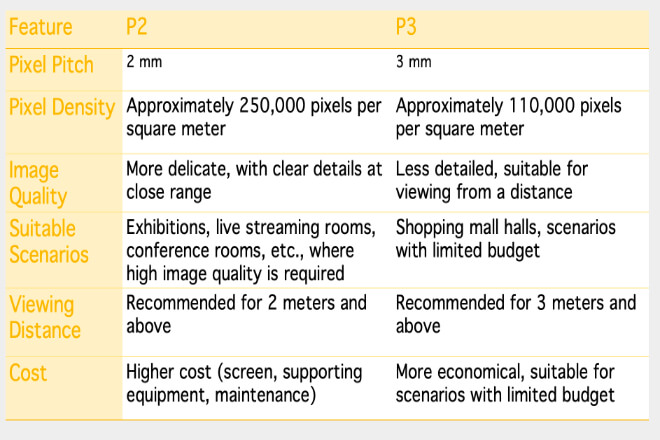
LED 디스플레이 화면을 선택할 때 "P2"와 "P3"라는 용어를 자주 접하게 됩니다. 사실 이는 도트 피치, 즉 픽셀 간 거리를 의미합니다. P2는 2mm이고 P3는 3mm입니다.
단 1mm의 차이이지만, 이는 사진의 품질과 사용자 경험에 큰 영향을 미칩니다.
P2의 도트 피치가 더 작아 단위 면적당 더 많은 픽셀을 탑재할 수 있어 화질이 더욱 선명해집니다. 예를 들어, 1제곱미터당 P2는 약 25만 개의 픽셀을 가지고 있는 반면, P3는 11만 개의 픽셀만 가지고 있습니다.
간단히 말해서, P2의 영상은 특히 가까운 거리에서 볼 때 더욱 선명해 보이고, 세부 사항이 흐릿해지지 않습니다.
적합 전시회, 생방송실, 회의실 등 화질에 대한 요구가 높은 장소.
그만큼 시거리 P2는 2미터 이상 거리에서 보는 것이 권장되고, P3는 3미터 이상 거리에서 보는 것이 적합합니다.
디스플레이 창이나 소규모 회의실처럼 화면이 사람과 가까운 경우에는 P2가 더 적합합니다. 쇼핑몰 로비처럼 거리가 먼 경우에는 P3이 충분합니다.
가격 측면에서 보면 P2가 더 비쌉니다. 화면뿐만 아니라 지원 장비와 유지 관리 비용도 상대적으로 비쌉니다.
P3는 경제적이어서 예산이 제한적이고 이미지 품질이 덜 요구되는 장면에 적합합니다.
일반적으로 P2는 이미지 품질이 더 좋으며 근거리에서 수요가 많은 상황에 적합합니다.
P3는 평균적인 화질을 제공하며, 중장거리 촬영과 저예산 촬영에 적합합니다. 어떤 카메라를 선택할지는 실제 필요와 사용 환경을 고려하는 것이 중요합니다.
2. 두 가격의 차이가 왜 명확한가요?

많은 사람들이 P2와 P3의 가격 차이에 대해 의아해합니다. 도트 간격은 단 1mm 차이인데 왜 가격이 이렇게 다를까요?
사실 이러한 현상에는 여러 가지 이유가 있는데, 주로 제조상의 어려움, 설치 및 디버깅, 시장의 수요와 공급이라는 세 가지 측면에서 나타납니다.
1) 제조상의 어려움
먼저 P2에 대해 이야기해 보겠습니다. 도트 피치가 작아서 1제곱미터당 더 많은 램프 비드와 드라이버 칩을 설치해야 하는데, 이는 P3의 거의 두 배에 달합니다.
이는 제한된 공간에 더 많은 부품을 채워 넣는 것과 같아서 당연히 훨씬 더 어렵습니다.
더욱이 램프 구슬의 배열은 매우 정확해야 합니다.
약간의 오차가 있어도 그림이 고르지 않을 수 있습니다. 자수하는 것과 같아서 한 땀도 틀릴 리가 없습니다.
회로 설계, 방열, 신호 전달 등에 대한 요구 사항도 더 높습니다.
생산 과정이 복잡하고, 수율이 낮으며, 비용은 당연히 상승합니다.
P3를 다시 살펴보겠습니다. 도트 피치가 더 크고, 램프 비드와 드라이버 칩의 개수가 상대적으로 적으며, 배열이 비교적 자유롭고, 생산이 비교적 용이하며, 비용도 저렴합니다.
2). 설치 및 디버깅
P2 화면의 접합은 매우 섬세하고 모듈은 작습니다.
색상 조정, 명도, 교정 및 기타 작업은 특히 신중하게 수행해야 합니다. 이는 많은 인력과 시간이 필요한 섬세한 수술을 하는 것과 같습니다.
현장 설치 시 기계 구조의 설계도 매우 세심해야 합니다. 그렇지 않으면 이음새가 고르지 않거나 밝기가 고르지 않게 될 수 있습니다.
후자의 유지관리도 비교적 복잡하며, 이러한 숨겨진 비용을 고려해야 합니다.
P3의 경우 접합이 비교적 간단하고, 모듈이 크고, 설치 및 디버깅이 쉽고, 기계 구조 설계에 대한 요구가 높지 않으며, 이후 유지관리가 용이하므로 숨은 비용이 자연스럽게 낮습니다.
3) 시장 수요와 공급
P2는 기술적 한계가 높고, 시장 수요가 비교적 작으며, 생산량이 부족합니다.
생산 공장이 적고, 자재 조달 비용이 높으며, 대량 생산이 어렵습니다. 수요와 공급의 관계로 인해 가격이 높습니다.
P3는 다릅니다. 오랫동안 사용되어 왔고, 생산 공장이 많으며, 자재 조달 비용이 낮고, 대량 생산으로 가격도 안정적입니다.
일반적으로 P2의 가격이 높은 이유는 재료를 더 많이 사용하기 때문이 아니라 제조 공정이 복잡하고, 설치와 디버깅이 어렵고, 시장 규모가 제한적이기 때문입니다.
따라서 LED 스크린을 구매할 때 단순히 도트 피치 매개변수에만 집중하지 말고 최소 도트 피치만 맹목적으로 추구하지 마세요.
이렇게 하면 돈만 낭비하는 것이 아니라, 실제로 자신에게 맞는 제품을 구매하지 못할 수도 있습니다.
3. 디스플레이 효과에서 P2의 강도는 무엇입니까?
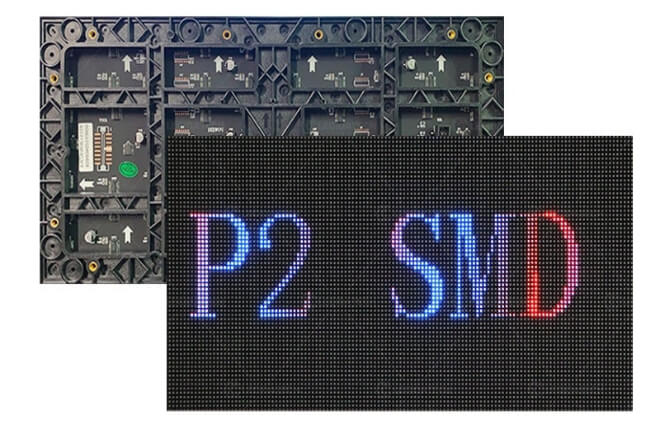
P2의 도트 피치는 2mm에 불과하고 픽셀 밀도가 매우 높아서 화면의 텍스트와 이미지의 가장자리가 특히 선명합니다.
특히 화면을 자세히 보면 흔히 나타나는 울퉁불퉁함이나 흐릿함은 보이지 않습니다. 이 장점은 더욱 뚜렷하게 드러납니다.
예를 들어, 회의실이나 생방송실에서는 청중이 비교적 가깝습니다.
P2 화면을 사용하면 텍스트와 아이콘을 명확하게 식별할 수 있어 시청이 더욱 편안하고 정보 전달이 더 정확해집니다.
P3에 비해 P2의 색상 성능은 더욱 섬세하고 풍부하며, 색상 레이어링이 강하고 자연스러운 전환을 보여줍니다. 화면이 눈부시지 않고 풍성해 보이며, 입자감이 훨씬 적습니다.
밝은 빨간색이든 진한 파란색이든, 더욱 사실적으로 복원할 수 있으며, 이는 특히 브랜드 색상이나 정교한 그림을 표시해야 하는 경우에 중요합니다.
P2 화면에서 비디오와 애니메이션을 재생하면 모자이크나 프레임 건너뛰기 현상 없이 화면이 더 매끄럽습니다.
픽셀 밀도가 높으면 세부 사항이 더 정확해지고, 역동적인 그림이 딱딱해 보이지 않습니다.
이런 방식을 사용하면 빠른 속도의 광고나 섬세한 애니메이션 효과도 부드럽게 표시되어 전반적인 시청 경험이 향상됩니다.
이러한 장점으로 인해 P2는 높은 화질이 요구되는 많은 장면에서 첫 번째 선택이 되었습니다.
라이브 방송 배경 벽과 같은 전시회 디스플레이 공간과 회의실의 대형 스크린.
P2 화면을 사용하면 화면이 더 전문적이 되고 정보 전달이 더 정확해질 뿐만 아니라 시각적 경험이 더 좋아지고 전반적인 등급 감각도 향상됩니다.
시각적 피로감을 줄이고 내구성을 높였습니다.
P2 화면은 디테일이 풍부하고 색상이 부드러워서 장시간 시청해도 눈이 피로하지 않습니다.
특히 지휘센터나 전시장 등 화면을 장시간 바라보는 상황에서는 이 기능이 매우 중요합니다.
청중은 편안하게 시청할 수 있고, 정보 수용의 효율성도 당연히 높아집니다.
4. 사용 시나리오에 따라 "가치 있는"지 여부가 결정됩니다.
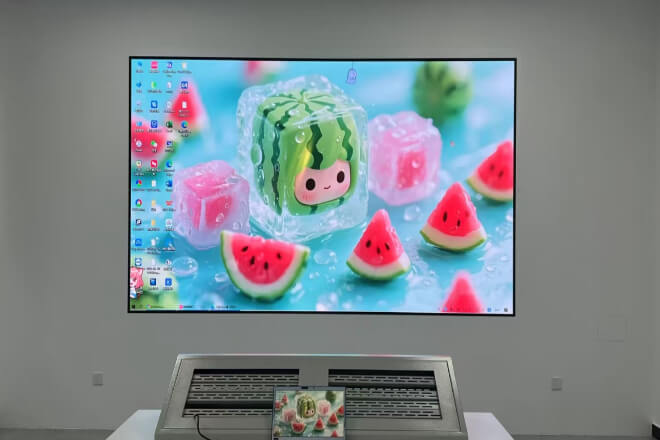
1) 회의실, 전시회 홀, 근거리 디스플레이 - P2가 더 적합합니다.
이런 경우 관객은 대개 화면과 몇 미터 이내로 가깝습니다.
P2는 도트 간격이 작고, 화면의 디테일이 풍부하며, 텍스트와 이미지 가장자리가 선명하고, 정보 전송이 더 정확하며, 전반적인 시각 효과가 더 편안합니다.
특히 데모를 하거나, 제품 세부 정보를 보여주거나, 아름다운 사진을 보여줄 때 P2는 눈에 띄는 개선을 가져올 수 있습니다.
2) 정사각형, 야외, 장거리 재생 - P3면 충분
이런 장면에서의 시청 거리는 보통 아주 멀어서, 10미터 이상, 심지어 수십 미터 이상 떨어져 있을 수도 있습니다.
P3 화면은 도트 피치가 더 크기 때문에 시청 요구를 충분히 충족할 수 있으며, 선명도가 충분하고 가격도 저렴합니다.
야외 환경은 조명이 복잡하고 해상도가 너무 높으면 눈에 띄기 어렵기 때문에 이런 장소에서는 P3가 비용 효율성이 더 높습니다.
3) 정말 그렇게 높은 화질이 필요한가요?
많은 경우 사용자는 "높을수록 좋다"고 생각하지만, 실제로는 구체적인 요구 사항에 따라 달라집니다.
예를 들어, 화면이 주로 간단한 텍스트 정보나 광고를 표시하는 데 사용되는 경우입니다.
시청 거리가 멀 경우 P2의 고해상도가 뚜렷한 이점을 제공하지 못할 수 있습니다. 화면을 선택할 때는 사용 환경과 시청 거리를 고려하는 것이 가장 경제적입니다.
5. 예산 제약 하에서의 비용 효율성 분석
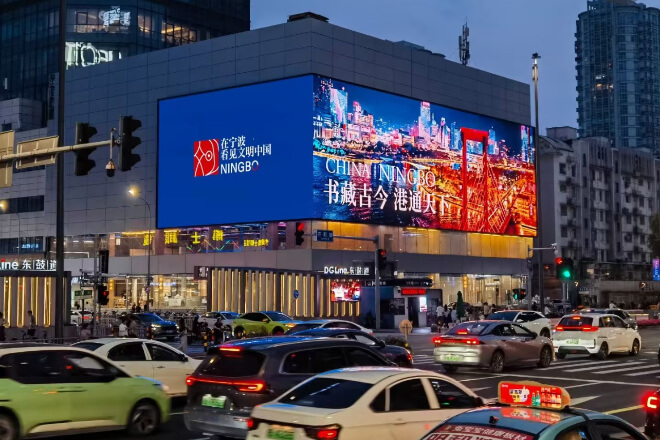
예산이 제한적일 때 P2나 P3를 선택하는 것은 많은 사람들에게 골치 아픈 일이 됩니다.
전반적으로 P3는 넓은 지역을 촬영해야 하지만 자금이 비교적 부족한 장면에 더 적합합니다.
P3의 도트 피치가 크기 때문에 1제곱미터당 사용되는 램프 비드와 드라이버 칩의 수가 적고, 재료 비용도 당연히 훨씬 낮습니다.
예를 들어 쇼핑몰의 대형 스크린, 광장의 옥외 광고판, 대형 이벤트의 배경 화면 등 P3는 적은 비용으로 더 넓은 디스플레이 면적을 만들 수 있으며, 비용 효율성도 상대적으로 높습니다.
또한, P3 화면은 실외 환경에서도 안정적으로 작동하고, 방풍 및 방진성이 뛰어나며, 유지 보수 비용도 상대적으로 저렴합니다. 일부 실외 환경에서는 매우 실용적인 선택이 될 수 있습니다.
P2만큼 해상도가 높지는 않지만, 먼 거리에서 시청하기에는 화질이 완벽히 충분하며, 관객은 흐릿함을 느끼지 못할 것입니다.
이와 대조적으로 P2는 회의실, 전시장, 생방송실 또는 근접 시청이 필요한 일부 전문적인 디스플레이 환경 등 디스플레이 효과에 대한 요구 사항이 높은 장소에 더 적합합니다.
이런 곳에서는 그림의 디테일, 텍스트의 명확성, 색상의 복원이 매우 중요합니다.
예산이 부족하더라도 많은 회사는 시각적 경험을 보장하기 위해 더 많은 돈을 쓸 의향이 있습니다.
결국, 명확하고 섬세한 사진은 고객에게 보다 전문적이고 고급스러운 인상을 줄 수 있습니다.
따라서 P2 또는 P3를 선택할 때 가장 중요한 것은 실제 필요에 따라 결정하는 것입니다. 주로 대규모 디스플레이를 사용하고 관객이 멀리 떨어져 있는 경우, P3가 더 경제적이고 실용적인 선택입니다.
하지만 근거리 시각 효과에 집중하고 선명하고 섬세한 영상이 필요하다면 P2에 투자하는 게 좋습니다.
간단히 말해, 예산과 사용 요구 사항을 합리적으로 충족해야만 실제로 돈을 쓰고 편안하게 시청할 수 있습니다.
6. 투자 수익률 관점에서 볼 때, 더 많은 비용을 지출할 가치가 있나요?
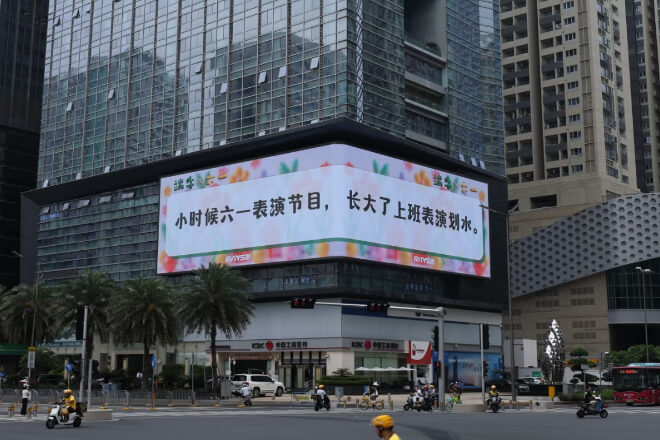
많은 사람들이 LED 스크린을 선택할 때 이렇게 생각합니다. P2에 더 많은 돈을 쓰는 게 정말 비용 효율적일까요?
고화질 사진이 실제 수익을 가져올 수 있을까요? 사실, 이는 여러분의 필요와 목표에 따라 달라집니다.
우선, 고화질 영상은 실제로 관객의 시각적 경험을 향상시킬 수 있습니다.
그림의 세부 묘사가 풍부하고, 색상이 밝으며, 전반적인 모습이 더 전문적이어서 사람들에게 고급스러운 느낌을 줍니다.
이는 브랜드 이미지를 개선하는 데 매우 유용하며, 특히 전시장, 회의실, 생방송 등 세부 사항에 민감한 상황에서 유용합니다.
선명하고 섬세한 화면은 고객이나 시청자에게 당신이 더 세심하고 신뢰할 수 있다는 느낌을 줄 수 있습니다.
둘째, 디스플레이 품질이 높으면 전환율도 높아질 수 있습니다. 예를 들어, 광고가 재생되는 경우.
그림이 선명하고, 텍스트와 제품 세부 정보가 명확하면 주의를 끌기가 쉽고, 정보가 더 직접적으로 전달되어 구매나 협력을 촉진하는 데 도움이 됩니다.
반대로, 화질이 좋지 않은 화면은 사람들에게 "싸구려"라는 느낌을 줄 수 있으며, 심지어 사용자의 제품 및 브랜드에 대한 신뢰에 영향을 미칠 수도 있습니다.
그러나 투자 수익률은 예산과 실제 이익에 따라 달라집니다. P2의 비용은 P3의 비용보다 상당히 높습니다.
구매하기 전에 평가하는 것이 가장 좋습니다. 이 투자의 일부를 보상할 만큼 더 나은 디스플레이 효과를 통해 고객 관심을 충분히 끌거나 매출을 늘릴 수 있습니까?
수익이 가격 차이를 확실히 커버할 수 없다면 그 투자는 비용 효율적이지 않을 수 있습니다.
요약하자면 P2 화면은 고품질의 시각적 경험과 브랜드 이미지, 고객 전환을 추구하는 사용자에게 적합합니다..
여P3 화면은 여전히 예산이 제한적이거나 화질에 대한 요구 사항이 낮은 장면에서 실용적이고 경제적인 선택입니다.
가장 적절한 투자 결정을 내리려면 실제 필요와 예산을 결합하는 것이 핵심입니다.
7. 고려할 만한 타협안이 있나요?
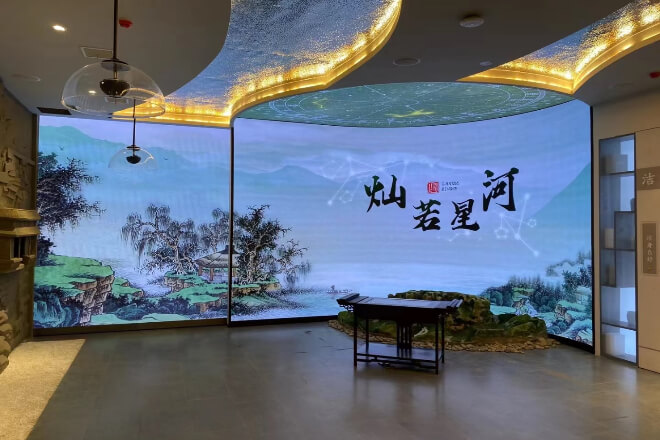
사실, LED 스크린을 선택한다고 해서 반드시 P2와 P3 중 하나를 선택해야 하는 것은 아닙니다. 때로는 타협적인 솔루션이 더 실용적이고 비용 효율적일 수 있습니다.
예를 들어, 시중에는 P2.5 제품이 많이 있는데, 도트 피치는 P2와 P3 사이입니다.
비교적 좋은 화질을 보장할 뿐만 아니라 비용도 절감할 수 있어, 좋은 절충안입니다.
예를 들어, 일부 고휘도 및 고대비 P3 화면은 기술적 업그레이드를 통해 더욱 밝은 색상과 더욱 선명한 디테일을 제공하는 화질을 개선했습니다. 또한, 다양한 장면에서 P2 화면을 대체할 수 있습니다.
이 외에도 지능형 디밍, 동적 보정, 색상 보정 등 화질 차이를 메울 수 있는 보조 기술도 있습니다.
소프트웨어와 하드웨어 최적화를 통해 화면이 더 균일하고 편안해 보이고, 거칠어 보이지 않습니다.
더 중요한 것은, 맹목적으로 가장 낮은 도트 피치를 추구하지 말고, 특정 장소, 시청 거리 및 사용 요구 사항에 따라 맞춤형 조정을 하는 것입니다.
예를 들어, 가까운 거리의 주 디스플레이 영역에는 P2를 사용하고, 더 먼 거리의 보조 화면에는 P3 또는 P2.5를 사용하면 시각적 요구를 충족할 수 있을 뿐만 아니라 불필요한 낭비를 피할 수 있습니다.
간단히 말해, 스크린을 선택하는 핵심은 "적절한 곳에 사용하고, 적절한 비용을 쓰는 것"입니다.
자신의 필요에 맞는 균형점을 찾으면 가장 좋은 효과와 투입-산출 비율을 얻을 수 있습니다.
8. 결론
이 기사를 분석하면 P2와 P3 LED 디스플레이의 차이점, 가격, 적용 시나리오에 대해 더 명확하게 이해하실 수 있을 것으로 믿습니다.
디스플레이를 선택할 때 중요한 것은 맹목적으로 고해상도를 추구하기보다는 실제 필요에 맞는 디스플레이를 선택하는 것입니다.
마지막으로 LED 디스플레이에 대해 더 알고 싶으시다면, 저희에게 연락주세요.
